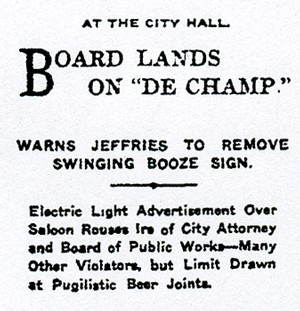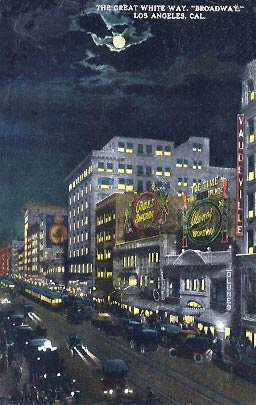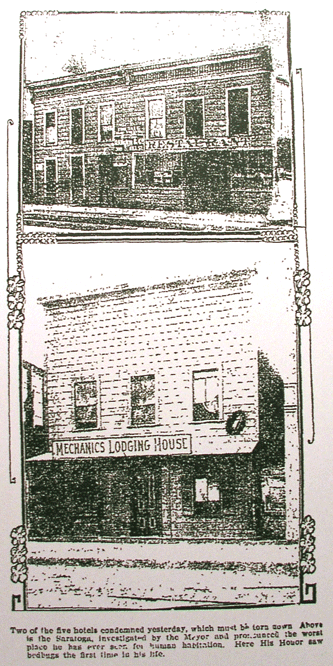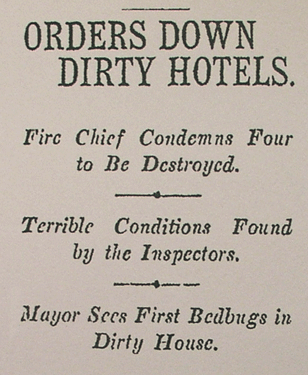
Jan. 21, 1907
Los Angeles
Mayor Arthur C. Harper addressed the crowd for a moment, reminiscing about a teacher who used to tell his pupils that someday, long after he was gone, people would get around Los Angeles in self-propelled vehicles.
And with that, Harper threw the switch, illuminating 10,000 electric lights at Morley’s Skating Rink on Grand between 9th and 10th Streets and beginning the insanity, formally unveiling the automobile in the first car show not only in Los Angeles, but on the West Coast.
More than 3,000 people poured through the exhibits in the first three hours of the show, which featured 97 gas-powered autos and two electric cars, as well as all manner of accessories such as odometers, speedometers, dashboard clocks and gas lamps. There was a personal appearance by Barney Oldfield with his famous “Green Dragon†racecar.
Not all of the exhibitors arrived in time for the opening night. The railroad car carrying the shipment of Pope-Toledos caught fire near Barstow and the Ford was delayed, although Henry Ford did attend the show, The Times says.
Great preparations had been made to display the vehicles: 9th and 10th Streets, as yet unpaved, were muddy from recent storms, but Grand was cleared of mud and a wooden causeway was built to the entrance. The Times notes that a canopy had been erected for people arriving in carriages.
The autos’ technical innovations were breathtaking: “At the space of the White garage a constant crowd looked over the Christman, a car built for the hardest kind of place, the desert,†The Times says. “The car is built for carrying passengers over no roads at all, for jumping off rocks and climbing over gullies and generally being abused.
“The Christman is a large, heavy, rugged-looking machine, with broad tread, large wheels and a body fitted with three seats, like an old-fashioned buckboard. Its frame is built like a railroad car, with truss rod underneath. In front is the motor, a Brennan double-opposed rated at 40 horsepower. This size is used in the car on exhibition, but the next ones turned out with have a 60 horsepower motor, capable of taking them anywhere.
“A peculiar system of individual clutch transmission is used, which has been changed a little since the first car was made. Formerly the car had no reverse and when Christman wanted to turn the machine around in the narrow streets of Goldfield he rushed at the curb, hit and bounced back and then continued the operation until he had bounced himself around.
“This operation seemed to have no deleterious effect on the car, but it was thought better to have a reverse as the method was rather strenuous on the passengers.â€
There were many questions and after a few days, salesmen became exhausted from explaining why a car engine needs pistons and why a manufacturer can’t leave off the differential to save weight. The show was extended because of its popularity, and was forced to close in part because most of the exhibition cars had been sold.
If anyone asked about mass transit, pollution or traffic, the comments were not recorded. No, the first thing people did when they got hold of their cars was to see how fast they could go.
Lmharnisch.com
Lmharnisch.blogspot.com
E-mail: lmharnisch (AT) gmail.com





 Here’s a vision of the future: electric signage along Broadway, ca. 1920, as pictured in, uh,
Here’s a vision of the future: electric signage along Broadway, ca. 1920, as pictured in, uh, 


 Much has been made of Bunker Hill, its rooming houses torn asunder, and of the wholesale postwar demolition of many a downtown landmark. Downtown hotels have fared the worst, though they limped along longest—the Lee, the Lankershim, the Gates, the Armondale, all held forth before being felled in recent memory. As much as we must blush at this collective ignominy, let us turn an eye back to some of our fallen comrades that predate, or were otherwise too shabby to be considered amongst, the brick and metal structures of our Gilded Age.
Much has been made of Bunker Hill, its rooming houses torn asunder, and of the wholesale postwar demolition of many a downtown landmark. Downtown hotels have fared the worst, though they limped along longest—the Lee, the Lankershim, the Gates, the Armondale, all held forth before being felled in recent memory. As much as we must blush at this collective ignominy, let us turn an eye back to some of our fallen comrades that predate, or were otherwise too shabby to be considered amongst, the brick and metal structures of our Gilded Age.

